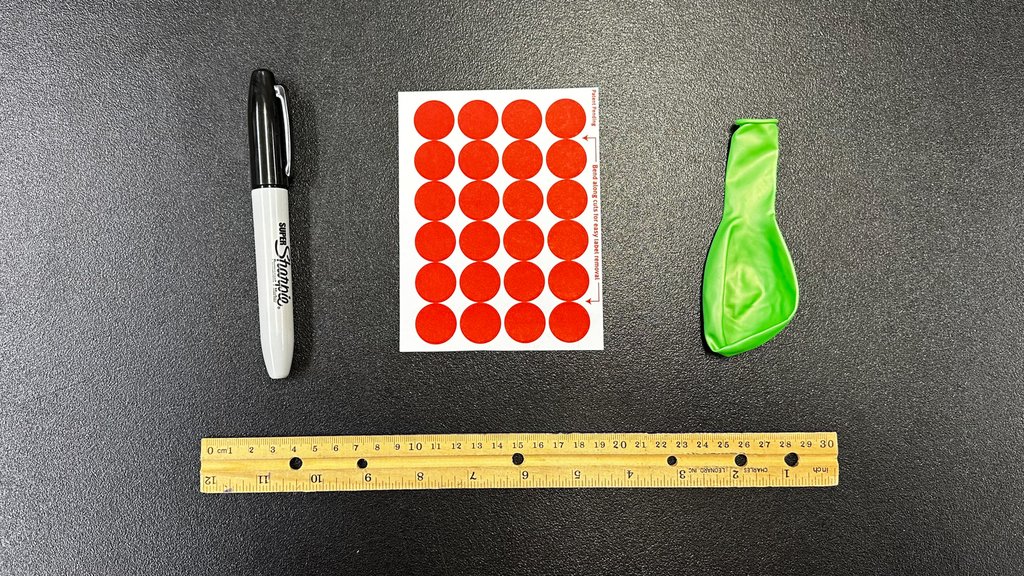Lesson .
.Model the Expanding Universe
Overview
Students learn about dark matter and dark energy, as well as the role they play in the expansion of the universe. Then, they will model the expanding universe using balloons.
Materials
- Balloons
- Small round stickers (five to 10 per group)
- Felt-tip marker
- Ruler
- (Optional) balloon pump
Management
- Gather enough materials to provide each group with a full set of materials.
- Have extra balloons available as some will pop.
- Consider incorporating the demo How Do We See Dark Matter? in Step 2 of the Procedures section to help students understand how scientists know dark matter exists.
Background
Since the moment of the big bang nearly 14 billion years ago, the universe has been expanding. Astronomers first measured this phenomenon in the 1920s and have been refining their measurements ever since. Now scientists know that the universe is not only expanding, but also the rate at which it is expanding is increasing. Before this discovery, scientists had believed that gravity from matter within the universe would eventually slow the expansion.
The matter that makes up the observable universe does not have enough mass to account for the accelerating expansion of the universe. Cosmologists – people who study the origin and evolution of the universe – believe that in addition to the matter we can see, such as planets, moons, dust, and stars, the universe contains dark energy and dark matter.
More is unknown than is known about dark energy and dark matter, but their presence can be inferred by the way they interact with the visible universe. We can determine how much dark energy exists by looking at how it influences the accelerating expansion of the universe. When it comes to dark matter, we can look at the gravitational effects on galaxy formation that can’t be explained by visible matter alone.
Dr. Jennifer Wiseman, a senior project scientist with the Hubble Space Telescope mission, explains how the mission has been helping scientists learn more about dark energy. Credit: NASA Goddard | Watch on YouTube
Based on theoretical models of the universe, dark matter accounts for approximately 27% of the universe and dark energy makes up 68%. Ordinary matter, like what is found on the periodic table, accounts for less than 5% of the total mass of the universe.
This animated pie chart shows rounded values for the three known components of the universe: visible matter (5%), dark matter (27%), and dark energy (68%). › Full video and caption
There are two complementary space missions seeking to explore the mysteries of dark energy, dark matter, and the accelerating expansion of the universe. The Euclid mission, a European Space Agency (ESA) space telescope with important contributions from NASA, is designed to study the expansion of the universe. Its findings, along with the findings of NASA’s Nancy Grace Roman Space Telescope, launching in 2027, will help scientists gain a better understanding of dark energy and reveal some of the hidden workings of our universe.
Procedures
Ask students to describe or explain what could cause an object to move. Students may say things like gravity, kinetic energy, or potential energy. Ask students if there are any common factors among the things they list. If needed, mention they are all related to mass and, therefore, matter.
Share with students that the energy (light, heat, radiation, etc.) and matter (planets, moons, stars, galaxies, gasses, etc.) that make up the observable universe account for less than 5% of the universe. About 27% of the universe is composed of what scientists call dark matter, and roughly 68% of the universe is dark energy. Explain how scientists measure and infer the presence of dark matter and dark energy as described in the Background section. Consider using the demo How Do We See Dark Matter? to help students understand how scientists know dark matter exists.
Give students five to 10 stickers to place in various spots on the balloon. Students can also mark the spot where the stickers will be placed so they can be returned to the correct spot if they fall off.
Instruct students to draw a lightwave on the balloon to represent light traveling between galaxies.
Have students partially inflate the balloon a bit more, again without tying it off. Ask students to make observations and measurements and report what they found.
Show students the animation below. Discuss how it shows the universe expanding at a constant rate compared with an accelerating rate. The animation can be looped for repeated exposure to the concept.
This side by side comparison shows a constant rate of expansion of the universe, represented by the expanding sphere on the left, and an accelerating rate of expansion of the universe, represented by the expanding sphere on the right. Each dot on the spheres represents a galaxy and shows how galaxies move apart from each other faster in the universe that has an accelerating rate of expansion.
Discussion
- What does your observation about the stretching of lightwaves mean for lightwaves as they travel across space over time?
- What are some limitations of this model of the universe?
- The model only shows the surface of the balloon. A more accurate model would include galaxies inside the balloon.
- Expansion of the model universe only occurs when it’s being pumped or being blown into. Actual expansion is continual and accelerating.
- The model only shows the surface of the balloon. A more accurate model would include galaxies inside the balloon.
- Expansion of the model universe only occurs when it’s being pumped or being blown into. Actual expansion is continual and accelerating.
Assessment
- Students should develop an explanation about what they have measured and observed. Explanations might include things like:
- As the universe expands, the distance between galaxies grows.
- As the distance between galaxies grows, galaxies themselves do not expand.
- As the universe expands, lightwaves traveling through space get stretched out.
- Students should notice that the galaxies are moving apart.
- Students should recognize the stretching of lightwaves as the universe model expands.
- Students may connect the stretching of lightwaves with a change in wavelength and type of energy (e.g., ultraviolet to visible light, visible light to infrared).
Extensions
Explore More
- Article for Kids: What Is Dark Matter?
- Article: What Is Dark Energy?
- Facts & Figures: Euclid Mission - NASA
- Facts & Figures: Nancy Grace Roman Space Telescope
NASA's Universe of Learning materials are based upon work supported by NASA under award number NNX16AC65A to the Space Telescope Science Institute, working in partnership with Caltech/IPAC, Center for Astrophysics | Harvard & Smithsonian, and the Jet Propulsion Laboratory.
Lesson Last Updated: Sept. 25, 2025







